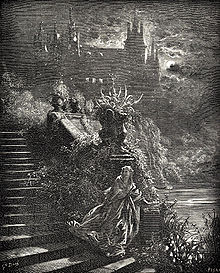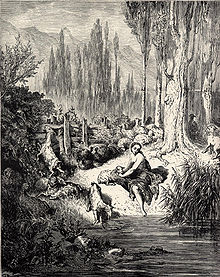- Donkeyskin
-
"Donkey skin" redirects here. For the food product, see Ejiao.
 Illustration by Gustave Doré
Illustration by Gustave Doré
Donkeyskin (French: Peau d'Âne) is a French fairy tale told by Charles Perrault.[1] Andrew Lang included it, somewhat euphemized, in The Grey Fairy Book.[2]
It is Aarne-Thompson folktale type 510B, unnatural love. Others of this type include Catskin, Little Catskin, Cap O' Rushes, Allerleirauh, The King Who Wished to Marry His Daughter, The She-Bear, Mossycoat, Tattercoats, The Princess That Wore A Rabbit-Skin Dress, and The Bear.[3]
Contents
Synopsis
A king had a beautiful wife and a rich castle, including a marvelous donkey whose droppings were gold. One day his wife died, after making him promise not to marry except to a woman whose beauty and attributes equaled hers. The king grieved, but was, in time, persuaded to seek another wife. It became clear that the only woman who would fit the promise was his own daughter.
She went to her fairy godmother who advised her to make impossible demands as a condition of her consent: a dress the color of the sky, a dress the color of the moon, a dress as bright as the sun, and finally, the hide of his marvelous donkey. Such was the king's desire to marry her that he granted all of them. The fairy godmother gave her a marvelous chest to contain all she owned and told her that the donkeyskin would make an excellent disguise.
 Illustration by Gustave Doré: as a servant
Illustration by Gustave Doré: as a servant
The princess fled and eventually found a royal farm where they let her work in the kitchen, despite her ugliness in the donkeyskin. On feast days, she would dress herself in the fine gowns her father had given her, and one such day, the prince came by her room and peeped through the keyhole. He fell in love at once, fell ill with his longing, and declared that nothing would cure him but a cake baked by Donkeyskin, and nothing they could say of what a dirty creature she was dissuaded him.
When Donkeyskin baked the cake, a ring of hers fell in it. The prince found it and declared that he would marry only the woman whose finger it fit. Every other woman having failed, he insisted that Donkeyskin try, and it fit. When she had dressed herself in her fine gowns, his parents were reconciled with the match. Donkey-skin later found that her father had remarried to a beautiful widow and everyone lived happily ever after.
Modern variants
- Deerskin, a novel by Robin McKinley
- "Donkeyskin," a story by Terri Windling
- "Donkeyskin," a poem by Midori Snyder (available online here)
- Pelzmantel: A Medieval Tale, a novel by K. A. Laity, Spilled Candy Books, 2003
- Peau d'âne (1970), a film directed by Jacques Demy and starring Jean Marais and Catherine Deneuve.
- Retelling in Jim Henson's The Storyteller as "Sapsorrow".
See also
- The Goat Girl
- Katie Woodencloak
- The Dirty Shepherdess
- The Tale of the Hoodie
- The Three Daughters of King O'Hara
References
- ^ Perrault, Charles. "Donkeyskin". University of Pittsburgh. http://www.pitt.edu/~dash/perrault11.html. Retrieved 7 June 2011.
- ^ Lang, Andrew, ed. "Donkeyskin". The Grey Fairy Book. SurLaLune Fairy Tales. http://www.surlalunefairytales.com/donkeyskin/index.html. Retrieved 7 June 2011.
- ^ Heiner, Heidi Anne. "Tales Similar to Donkeyskin". SurLaLune Fairy Tales. http://www.surlalunefairytales.com/donkeyskin/other.html. Retrieved 7 June 2011.
External links
Categories:- Works by Charles Perrault
- Fictional princesses
Wikimedia Foundation. 2010.
